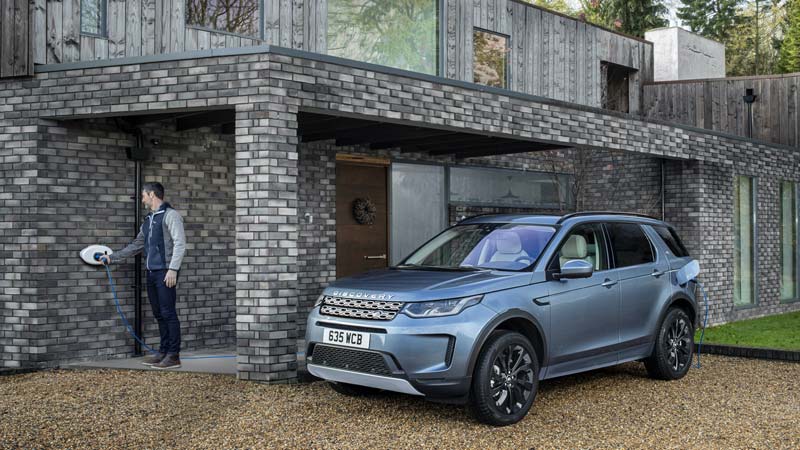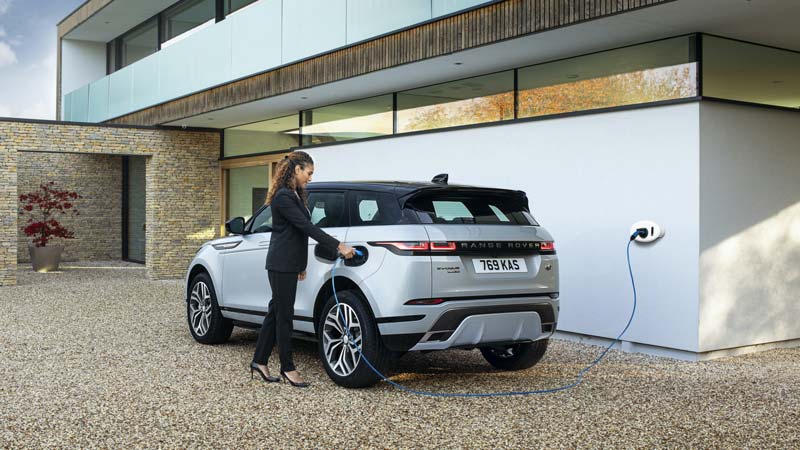The Range Rover Evoque and Land Rover Discovery Sport will be available in Australia in the second quarter of 2021 as plug-in hybrid vehicles (PHEVs), using Jaguar Land Rover’s newest plug-in hybrid system.
The new plug-in hybrid system consists of a three-cylinder, 1.5 litre engine producing 147kW power coupled with an 80kW rear electric motor powered by a 15kWh battery that delivers up to 66km pure electric driving range for the Evoque and up to 62km for the Discovery Sport.=
It’s the smallest engine available to date in JLR’s Ingenium series, which also has four and six cylinder variants.
As such, the company says it will reduce fuel consumption of the Range Rover Evoque to as little as 1.4 litres of petrol per 100 kilometres and for the Land Rover Discovery Sport, fuel consumption is reduced to 1.6 litres per 100 kilometres.
To put that in perspective, the 2020 Range Rover Evoque P300e with 2.0 litre, four cylinder engine is rated for 7.3l/100km combined while the 2020 Land Rover Discovery Sport P300e with 2.0 litre, four cylinder engine uses 8l/100km combined.
That is, if the fossil-fuelled engine is needed – with 62-66km electric driving range (double the average Australia daily commute of around 31km according to the Australian Bureau of Statistics 2016) and the ability to recharge at a public DC fast charger at a maximum rate of 32kW, only a half hour is needed to reboost the battery if extra range is needed.
At home or at locations such as shopping centres where there are AC “destination” chargers, the battery recharges within 1.5 hours at a top rate of 7kW.

“Designed, engineered and manufactured in-house, the modular, scaleable and flexible architecture of our Ingenium family allows us to be one of the first to market with a three-cylinder plug-in hybrid system, giving our customers even more choic,” JLR executive director of product engineering Nick Rogers said in a statement of the new PHEV system.
“The combination of electrification, downsizing and lightweighting gives impressive fuel consumption, electric range and zero-emissions urban driving. Whether driven longer distances, off-road or around town, our latest plug-in hybrid offers the same great Land Rover capability and composure with all-electric driving and world-class efficiency.”
Regenerative braking ensures efficient use of power while driving, allowing both models to recapture energy when braking or driving downhill.
Another perk of the inclusion of a 15kWh battery in both the upcoming Evoque and Discovery Sport models is the ability to pre-condition both the battery and vehicle interior – of particular use if plugged into mains power so as to not draw power from the battery.
This can be controlled from Land Rover’s “InControl Remote” smartphone app, which can also be used to monitor battery state of charge, or schedule charge times to get the most out of off-peak tariffs.
Both models will offer a variety of selectable driving modes to get the best driving performance, which according to JLR is nothing to be sniffed at with max torque output put at 540Nm – keepingin mind, says JLR, that peak power for the engine and the motor are not delivered at the same speed.
On hybrid mode, the PHEV system will use both the engine and the motor to adapt to driving conditions and the current status of the battery. By entering a destination the system will also “intelligently integrate route and GPS data to maximise efficiency and comfort for the selected journey,” says JLR.
An EV-only mode is also available, that can be utilised when the battery status is sufficient for completely zero tailpipe emissions driving. Additionally, a “save” mode can be used to prioritise the engine and maintain the battery state of charge.
As is common with plug-in hybrid systems, the engine will kick in and shut off the electric motor at higher speeds – in the case of the Evoque and Discovery Sport this will happen above 135km/hr – well above Australia’s top speed limits.
RenewEconomy and its sister sites One Step Off The Grid and The Driven will continue to publish throughout the Covid-19 crisis, posting good news about technology and project development, and holding government, regulators and business to account. But as the conference market evaporates, and some advertisers pull in their budgets, readers can help by making a voluntary donation here to help ensure we can continue to offer the service free of charge and to as wide an audience as possible. Thankyou for your support.

Bridie Schmidt is associate editor for The Driven, sister site of Renew Economy. She has been writing about electric vehicles since 2018, and has a keen interest in the role that zero-emissions transport has to play in sustainability. She has participated in podcasts such as Download This Show with Marc Fennell and Shirtloads of Science with Karl Kruszelnicki and is co-organiser of the Northern Rivers Electric Vehicle Forum. Bridie also owns a Tesla Model Y and has it available for hire on evee.com.au.

